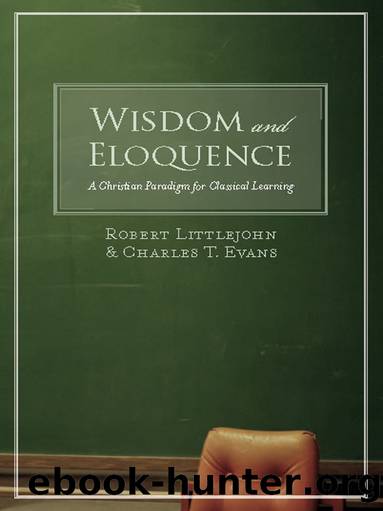Wisdom and Eloquence by Robert Littlejohn

Author:Robert Littlejohn
Language: eng
Format: epub
Tags: ebook, book
Publisher: Crossway
Published: 2017-07-21T00:00:00+00:00
ARITHMETIC
It is especially critical that from the earliest years basic arithmetic be taught in an incremental and cumulative manner and that students be allowed sufficient interaction with the material to achieve mastery. More than any other discipline, math is a cumulative exercise, building year by year. Students who have a âbad yearâ in math are likely to suffer for years as a result, and a mastery focus in the curriculum can help to ensure that students are not penalized because the school has low standards or inexact goals for student success. This means beginning with the simplest principles and sticking with them until they are thoroughly apprehended before moving to more complex principles.
As with reading, writing, and spelling skills, we are seeking autoÂmaticity. The basic skills should be second nature to our students so they are not hindered in tackling more complex computations by lack of facility in the basics. For younger students, and perhaps for older, the use of multiple modalities is imperative. Remember Hugo of St. Victor pacing off the geometric shapes on the floor of his room? This means that manipulatives and other tactile and kinesthetic tools should be an integral part of our pedagogy. Likewise, the rudiments of all the mathematical subdisciplines should be woven into the fabric of the early curriculum. Elementary principles of geometry, algebra, and statistics should be taught as soon as their foundational skills have been understood, along with understanding the calendar, timelines, and the analog clock.
Basic principles should be reinforced incrementally and cumulatively, so that things learned a week or a month ago are reviewed and tested again and again. This principle is antithetical to the organization of most published mathematics curricula that move from unit to unit as if every math principle is somehow isolated and independent of all others. If we allow our students to heave a sigh of relief because that terrible unit on fractions or negative numbers is behind us, we effectively doom them to struggle with mathematics throughout their educational careers.
There are not very many published examples of an incremental approach to teaching math, but one is worth mentioning. John Saxon realized that his students were frustrated with his algebra class because the text jumped from topic to topic without building upon previously mastered knowledge. He devised an incremental approach that had his students eagerly anticipating the quadratic equation because of their mastery of the elements of the formula in the preceding incremental lessons. Saxon believed students were not ready for complex principles until they had achieved automaticity with the simpler elements that naturally piece together to form the more complex principle or process. With this in mind, Saxon devised a curriculum that backs incremental learning down to fourth grade. His associates have since provided a program that backs his pedagogical approach down to kindergarten. In other words, he used a 12-K approach to curriculum development.
Incremental methods are sometimes maligned for three basic reasons. The repetitive pace tends to bore students whose brains have grown accustomed
Download
This site does not store any files on its server. We only index and link to content provided by other sites. Please contact the content providers to delete copyright contents if any and email us, we'll remove relevant links or contents immediately.
| Adult | Children & Teens |
| Home Schooling |
Habits of Grace by David Mathis(1894)
Anxious for Nothing by Max Lucado(1778)
A Prophet with Honor by William C. Martin(1645)
Peace with God by Billy Graham(1617)
Long Bright River by Liz Moore(1524)
Whisper by Mark Batterson(1386)
Expectation by Anna Hope(1367)
The Wondrous Workings of Planet Earth by Rachel Ignotofsky(1233)
Fortitude by Dan Crenshaw(1139)
Taste and See by Margaret Feinberg(1079)
Answers Book for Kids, Volume 3 by Ken Ham & Cindy Malott(1062)
I Declare War by Levi Lusko(1042)
Everybody, Always by Bob Goff(1031)
Your Story Matters by Leslie Leyland Fields(1028)
ST01 by Unknown Author(1020)
If by Mark Batterson(1020)
Power for Living by T. D. Jakes(994)
The Case for Miracles by Lee Strobel(993)
The Alpha by Unknown(987)
